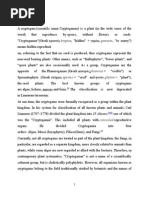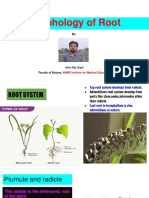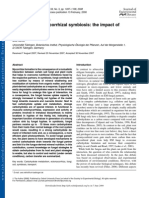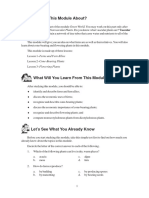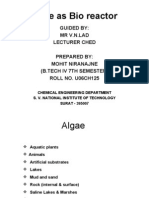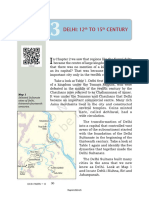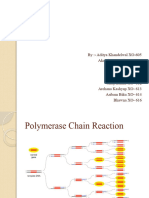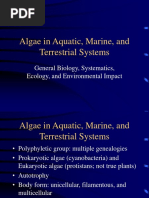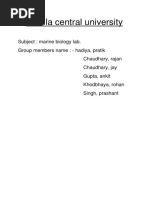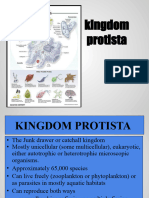Phaeophyceae
Phaeophyceae
Uploaded by
Sagar Das ChoudhuryCopyright:
Available Formats
Phaeophyceae
Phaeophyceae
Uploaded by
Sagar Das ChoudhuryCopyright
Available Formats
Share this document
Did you find this document useful?
Is this content inappropriate?
Copyright:
Available Formats
Phaeophyceae
Phaeophyceae
Uploaded by
Sagar Das ChoudhuryCopyright:
Available Formats
Phaeophyceae
Discipline Courses-I
Semester-I
Paper: Phycology and Microbiology
Unit-X
Lesson: Phaeophyceae
Lesson Developer: Inderdeep Kaur
College/Department: SGTB, University of Delhi
Institute of Lifelong Learning, University of Delhi
Phaeophyceae
Table of Contents
Chapter: Phaeophyceae
Introduction
Range of thallus
Characteristic features
Economic importance
The Unique Identity (UID) of kelps
Summary
Exercise/ Practice
Glossary
References/ Bibliography/ Further Reading
Institute of Lifelong Learning, University of Delhi 1
Phaeophyceae
Introduction
Brown algae or class Phaeophyceae (Fritsch 1945) along with diatoms and oomycetes
belong to a group called heterokonts (Anderson 2004)’. They are very distantly related to
their counterparts, green and red algae (Baldauf 2003). A large group of mostly marine,
multicellular algae, Phaeophyceae is seen along rocky shores and in shallow waters typically
attached to rocks or substratum of colder Northern hemisphere waters (Fucus sp) while a
few ‘browns’ such as Sargassum sp and members of Dictyotales are tropical warm water
inhabitants. Only seven species are fresh water inhabitants, e.g., Heribaudiella fluviatilis,
Sphacelaria fluviatilis, Pleurocladia lacustris, Porterinema fluviatilis, Ectocarpus siliculosus
and Bodanella lauterborni (Linda et al 2007). However, some are brackish water (Fucus
vesiculosus) and saline water inhabitants. One of the brown seaweeds Pelvetia is known to
‘shun’ water (Rugg and Norton 1987) and if left submerged for more than six hours out of
twelve, it begins to decay.
Range of thallus
Brown algae exist in a wide range and forms where the smallest members of the group
appear as tiny feathery tufts of thread-like cells, a few cms long e.g., Ectocarpus. Other
brown algae, like rockweeds (Fucus sp) and leathery kelps are conspicuous in waters due to
their size which ranges from 2 feet tall sea palm Postelsia to the giant kelp Macrocystis
pyrifera which grows over 45 m long and is the largest known alga.
Institute of Lifelong Learning, University of Delhi 2
Phaeophyceae
Figure: The ’Browns’
A. Ectocarpus, belonging to Ectocarpales has the simplest thallus amongst the browns
which in most of the species is feather-like. Source:
http://upload.wikimedia.org/wikipedia/commons/a/a6/Ectocarpus_siliculosus_Crouan_%282%29.jpg
B. Padina belonging to Dictyotales has a fan-like leafy thallus. The hairs and the sori
are borne in rings.
Source:http://calphotos.berkeley.edu/imgs/512x768/4444_4444/0311/6607.jpeg
C. Pelvetia canaliculata, belonging to Fucales is an upshore species and is known to
shun water. Source: http://upload.wikimedia.org/wikipedia/commons/c/c4/Pelvetia_canaliculata.jpg
D. Dictyota, from Dictyotales shows a dichotomously branched thallus with growth
occurring at each frond tip. Source:
http://upload.wikimedia.org/wikipedia/commons/thumb/0/0b/Capo_Gallo_Dicotoma.jpg/220px-
Capo_Gallo_Dicotoma.jpg
E. Sargassum muticum, a fucalean commonly known as gulf wrack shows an
angiosperm-like stem and leaves. Air bladders or pneumatocysts help the plant stay
afloat.
Institute of Lifelong Learning, University of Delhi 3
Phaeophyceae
Source:http://3.bp.blogspot.com/_HEkoxfFADrM/S76du0p7g6I/AAAAAAAAE3s/UU5uBriYCDw/s400/sarg
asso.jpg
Considering the body plan, the members may range from uniseriate branched filaments to
pseudoparenchymatous (or haplosticous) to complex parenchymatous thalli with multiple
cell types (polystichous) (Lee1999). In polystichous construction the cell types include
special meristematic tissue (meristoderm in Fucales) and conducting tissues (trumpet
hyphae in Laminariales). They may also form small crusts (Lobophora) and cushions and
also occur as leafy free floating mats formed by Sargassum sp. Delicate felt-like strands as
in Ectocarpus and foot-long flattened thalli resembling a fan as in Padina are also some of
the expressions of Phaeophycean morphology. Algae like Sargassum muticum, Undaria
pinnatifida and Turbinaria ornata are considered to be amongst important invasive brown
seaweeds.
Characteristic features
A few features set Phaeophyceae apart from all other algae. These are:
The members possess a characteristic colour ranging from an olive green and
passing through various shades of brown. The particular shade depends upon the
amount of photosynthetic pigment- fucoxanthin present in the plastids. Besides
fucoxanthin, these algae contain beta-carotene and chlorophyll a and c as the
photosynthetic pigments.
All brown algae are multicellular and are the only group of seaweeds which does not
have members that are either single celled or colonial.
The cell wall has cellulose and alginates, latter comprising a larger proportion along
with fucoidans, the sulphated polysaccharides. Alginates are non toxic salts of
alginic acids (Li et al 2008) and are used to stabilize emulsions and suspensions.
Both these phycocolloids from brown algae have great industrial application (Se
Kwon Kim 2013, Balch 1992).
The cells lack true starch as reserve food but have laminarin; the transport form
commonly being mannitol.
Growth in most brown algae occurs as a result of apical cell activity concentrated
towards the tips. However, a few forms like Ectocarpus grow by a diffuse unlocalized
growth in which new cells are formed anywhere on the thallus. Laminaria, shows
formation of annual growth rings, the phenomenon resembling stem growth in higher
plants. Concentric rings are visible in cross section of the stipe of Laminaria sp.
The deposition of secondary cortex resulting in formation of these rings is
Institute of Lifelong Learning, University of Delhi 4
Phaeophyceae
demonstrated to be an annual phenomenon and consequently stipe ring number can
be used to determine individual age (Klinger et al 1988).
Whatever their form of growth, the body organization in all brown algae is thallus
type indicating absence of xylem and phloem from the tissue plan. Holdfast is a
root- like structure which serves to anchor the alga firmly in the substratum as well
as helps in regeneration (as in Sargassum). The highly branched disc may lead to
formation of haptera as in kelps and some fucoids like Turbinaria. Stipe or stalk or
stem-like structure may be short remain undivided (as in Laminaria) or may develop
into a large complex branched structure running through out (as in Sargassum).
Many members have a flattened portion arising from stipe/stem that may resemble
leaf and this has been variously referred to as blade, lamina or frond. In many
species lamina has a midrib and wings; blades are often also the sex bearing parts of
the alga.
The thalli show three distinct regions of tissue organization--- central medulla,
middle cortex and outermost meristoderm. In Laminaria phloem-like cells known
as trumpet cells are seen in the medulla. The higher forms belonging to Laminariales
and Fucales have air bladders or pneumatocysts which make the thallus buoyant.
The only exception is seen in Pelvetia which does not have air bladders and grows on
rocks forming uppermost zone of algae.
The plastids of brown algae may be disc-like, parietal or stellate in shape. The
plastid is enveloped by two unit membranes, the inner and outer chloroplast
membrane. In addition to this, there are two additional membranes that form the
chloroplast endoplasmic reticulum which maintains continuity with the outer
envelope of the nucleus. Phaeophycean plastids have three thylakoids per lamella
and a girdle lamella near chloroplast envelope. Pyrenoids are commonly seen in
some orders (e.g., Ectocarpales) and are poorly developed in others (Fucales).
Physodes, the phlorotannin containing vacuoles perform a number of ecological
functions like deterring herbivores, healing the wounds, acting as a shield against
intense sunlight and are also responsible for dark brown discolouration of the
decayed alga.
Many brown algae especially the kelps, concentrate iodine in their cells. They also
release large quantities of volatile brominated methane into the atmosphere and are
linked to the current environmental issues (Turan and Neori 2010).
Reproduction is highly evolved in Phaeophyceae with advanced orders exhibiting
great adaptation for intertidal gamete release, gamete union and propagule
Institute of Lifelong Learning, University of Delhi 5
Phaeophyceae
dispersal. All the three modes of reproduction : vegetative, asexual and sexual are
met with. Populations in brackish waters however, have almost totally lost their
ability to reproduce sexually and their primary method to reproduce is vegetative.
Some like Dictyota dichotoma have successfully propagated asexually through
fragments created by biotic and abiotic stress. The drift plants of another invasive
alga Sargassum muticum are fertile with androgynous conceptacles resulting in
higher rates of reproduction while the alga is afloat. (
htpp://www.doeni.gov.uk/niea/sargassum/pdf ).
During the long period of evolutionary time scale, brown algae have evolved many unusual
characteristics that are not found in the other groups, and these include a number of
features that have exquisitely adapted these organisms for the harsh environment of
intertidal and subtidal zones. These are given below:
Endosymbiosis and origin of chloroplasts----The chloroplasts of heterokonts such as
brown algae have a more complicated origin. The plastids have four concentric membranes
and the plastids have been acquired via a process of secondary endosymbiosis involving the
capture of red alga (Archibald 2012).
Complex multicellularity----The Phaeophyceae are one of the five eukaryotic groups (the
other four being animals, green plants/algae, fungi and red algae) to have evolved complex
multicellularity, a feature that has arisen rarely during evolution (Cock et al 2010).
Life cycles and mating types----In addition to a complex multicellular organisation,
brown algae exhibit several distinctive life cycles and mating behaviours. Life cycles range
from nearly isomorphic(where haploid and diploid phases are morphologically similar) life
cycle of Ectocarpus to diplontic animal-like in Fucus. Some members such as Laminaria
show heteromorphic alternation of generations. The members show both dioecious and
monoecious states and gametes may range from isogamous to anisogamous in lower
forms as in Ectocarpus to oogamous in advanced fucalean members (Graham and Wilcox
2000). The phenomenon of pheromone action and gamete union is highly advanced in
various members.
Early embryogenesis----Fertilization is external and involves union of naked gametes that
are released into the surrounding seawater. This feature has been exploited widely to study
events in early development including gamete fusion at fertilization, establishment of zygote
polarity, the involvement of cell walls in early developmental signalling, embarking on first
cell cycle, coupling between cell cycle and developmental processes and other aspects of
embryogenesis (Berger et al 1994, Corellou et al 2001).
Institute of Lifelong Learning, University of Delhi 6
Phaeophyceae
Response to biotic and abiotic stress----The brown algae represent novel model
systems for several aspects of responses to biotic (from grazers and pathogens) and abiotic
stress (variation in temperature, immersion, light, wave action and other mechanical forces
like grazing). Also included are studies on innate immunity (Potin et al 2002), and novel
pathosystems (Maier et al 2000).
Genetic regulation---- Life cycles like that of Ectocarpus generate interest because they
indicate the existence of genetic control involved in mechanisms that regulate deployment
of the two alternative, independent (haploid and diploid) developmental programmes,
influencing whole organism development. Fucales and Laminariales have been extensively
investigated in the past, but due to the large genome size (700 and 1100 Mbp respectively)
have been found to be poorly adapted for genomic and genetic approaches. Ectocarpus
siliculosus on the contrary because of small genome size, short life cycle that be completed
in the petri dishes (Müller et al 1998), its high fertility and rapid growth (life cycle can be
completed in 2-3 months), and the ease with which genetic crosses can be made (Peters et
al 2004).is the preferred model being studied. These studies have given impetus to brown
algal research that has not only provided insight into specific biological processes, but also
yielded information about the brown algal evolution which has occurred over the ages
evolving them into complex multicellular organisms (http://www.vib.be/en/about-
vib/annual-eport/2011/research/Pages/TheEctocarpus genome yields information about the
evolution of brown algae)
Economic Importance
Phaeophyceae are the key primary producers in intertidal shallow and deep subtidal reefs.
Some like Undaria pinnatifida, Turbinaria ornata and Sargassum muticum have become
invasive and are known to pose threat to native species and also grow over and smother
coral reef and native algal communities, killing extensive areas of native habitat
(http://malamamaunalua.org/problems/problems-science-invasive-algae/). Almost all
members play an important role, both as food and as habitat for a large number of other
marine organisms. For instance, Macrocystis, the giant kelp is known to form prominent
underwater forests supporting a great biodiversity under the canopies. Another example is
Sargassum which creates thick forests in the tropical waters of the Sargasso Sea in which
thrive a set of organisms.
Institute of Lifelong Learning, University of Delhi 7
Phaeophyceae
A B
F
Seaweed multi billion
dollar industry G
E
Figure A-G. Seaweed applications
A. Maxicrop, an organic fertilizer from Ascophyllum nodosum, can be used on the entire
lawn besides bulbs and cuttings. http://www.organic-gardening-
shop.com/Agorganics/Images/FullImage/MX001MX002.jpg
B. Alga grand a popular liquid fertilizer with growth hormones, amino acids and
nutrients for self-protection. http://www.liquidfertilizerorganic.com/wp-
content/uploads/2011/03/LIQUID-KELP-FERTILIZER-ORGANIC-AGGRAND.jpg
C. Wakame salad from Undaria is common in USA and Asia.
http://upload.wikimedia.org/wikipedia/commons/thumb/f/f9/Boiled_wakame.jpg/220
px-Boiled_wakame.jpg
D. Seaweed biscuits, the nutraceuticals. http://3.bp.blogspot.com/_cuENz-
xNstE/TUbfNtQ73bI/AAAAAAAABik/dZ_1Gi0ItCQ/s1600/310120111867.jpg
E. Seaweeds have a number of applications by virtue of their medicinal value, the
pharmaceuticals. http://www.tennis.com/your-game/2012/09/superfoods/39552/
F. Thalasso therapy—seaweed body wrap gives ‘beautiful you’, the cosmaceutical.
http://s3-media2.ak.yelpcdn.com/bphoto/XS-67PU2R1QPua8xha48FQ/o.jpg
G. Combating global warming with seaweeds.
http://www.cepp.utm.my/rcentre/files/Seaweed.jpg
The Browns form an important pillar of multibillion dollar seaweed industry. They find a wide
range of uses in food, cosmetics and fertilizer industry. The members are widely used as
Institute of Lifelong Learning, University of Delhi 8
Phaeophyceae
Seaweed Liquid Fertilizers (SLF) and are applied as foliar sprays and root drench. This has
led to setting up of seaweed fertilizer industry in many European and Asian countries. The
health benefits of browns are also immense and in recent times they are recommended as
nutraceuticals and food supplements. They have become popular sea vegetables like
kombu (Laminaria sp), and wakame (Undaria) are common brown sea vegetables. Brown
algae are the only plant source of thyroid hormones and are included in diet for the iodine
content. The regular kombu consumption as advised by the nutraceutical companies is
believed to help in improving coronary artery disease, bring healthier liver function and
faster food transmit time in digestive tract. The macro algae consumed as sea vegetables
contain levels of fibre that are comparable to the vegetables. Laminaria digitata contains
6.2% fibre higher than that contained in prunes, apples and banana with same weight.
Algin obtained from the walls of brown algae is generally not digestible but has a great
potential as heavy metal detoxifying agent. When added to the diet as algin powder, it can
bind heavy metals present in the food steam and remove them out with the stool. In the
cosmetic industry they are being widely used in thallasotherapy (a form of external
macro algal treatment is an ageless, health restorative technique). A mineral rich
blend of seaweed extracts and sea salt crystals that hydrate and soften the skin is being
used world over. Besides this brown algae are popular in, spa and face packs to detox the
body system and have a great application in anti ageing creams, shampoos and gels
(Vijayaraghavan and Kaur 1997). The brown seaweeds are also implicated in cutting down
green house effect. Highly productive seaweed species can contribute significantly to the
annual biological drawdown of CO2 and the global carbon cycle (Turan and Neori 2010).
They are increasingly gaining attention as a novel source of bioactive molecules. IODUS 40,
a formulation known to stimulate natural defense response of crop plants.is derived from a
storage glucan of Laminaria digitata. The characteristic secondary metabolites namely
diterpenes, phlorotannins and small C 11 acetogenins have industrial applications (Blaut et
al 2007).
PONDER OVER
Seaweed beds can serve as a significant carbon dioxide (CO 2) sink while also satisfying
global needs for food, fodder, fuel, and pharmaceutical products. Using innovative research
approaches, Korean scientists have established the Coastal CO 2 Removal Belt (CCRB), which
comprises both natural and man-made plant communities in the coastal region of southern
Korea. Implemented on various spatial–temporal scales, this scheme promotes the removal
of CO2 via marine forests. For example, when populated with the perennial brown alga
Ecklonia, a pilot CCRB farm can draw down ∼10 t of CO2 per ha per year. This success is
Institute of Lifelong Learning, University of Delhi 9
Phaeophyceae
manifested by an increment in biomass accumulations and a decrease in the amount of
dissolved inorganic carbon in the water column (Turan and Neori 2010).
Due to the wide applications of this group of algae, their demand in global market has
increased many folds and they are now said to form a multi million dollar industry. The
overexploitation of these seaweeds has threatened the very existence of this marine
resource. Researchers all over the globe are experimenting to increase the quality of the
brown ‘sea vegetables’ through genetic engineering and also trying to meet the demand by
carrying out mariculture of the seaweeds (Vijayaraghavan and Kaur 1997).
According to Fritsch (1945), there are nine orders:
Ectocarpales
Tilopteridales
Cutleriales
Sporochnales
Desmarestiales
Laminariales (commonly known as KELPS)
Sphacelariales
Dictyotales
Fucales
The Unique Identity (UID) of kelps
Image: The giant Kelps
Institute of Lifelong Learning, University of Delhi 10
Phaeophyceae
Source : http://vintageprintable.com/wordpress/wp-content/uploads/2010/08/Botanical-Kelp-
178x300.jpg
"Kelp" commonly refers to seaweeds of the brown algal order Laminariales, having large
flat, leaflike fronds, a root-like holdfast also known as hapteron, and a flexible stipe (stem-
like portion), and blades (flattened expansions often resembling leaves). The life cycle of
the kelp shows alternation of a large spore-producing tough leathery stage (the sporophyte)
and a microscopic gamete-producing stage (the gametophyte). Most of the kelps are found
in the Pacific Ocean, while a restricted number occupies the Atlantic waters. They are well-
adjusted for cold waters where they usually dominate the lower intertidal and upper subtidal
floras. Dense growth of kelps results in Kelp forests that constitute important marine
ecosystems in coastal areas of the world, and can support important commercial and
recreational fisheries. Several species of kelp are considered economically important and
have also been employed in western folk medicine. Until very recently, however, there has
been limited evidence of pharmacological value, aside from the effects of compensating for
iodine deficiency. Kelp tablets and powders have become popular herbal preparations in
North America, and claims have been made that kelp products are useful in treating a
variety of ailments. The therapeutic properties of kelp have been attributed particularly to
the trace minerals, especially iodine, which is typically 20,000 times as concentrated in the
seaweed by comparison with its aquatic habitat. The very high iodine content of brown
algae led to their use in goiter medicines, but the variability of concentrations and the
varying absorption conditions for bound and unbound iodine in the plant has made such
algal therapy obsolete. Another interesting medical application is based on the ability of the
dried stipes of Laminaria to expand their original circumference 3-5 times on wetting.
These dried stipes have been used to produce non-instrument mechanical dilation of the
cervical canal during birth and gynaecological treatment.
Although kelps are thought to inhibit heavy metal absorption in humans, those growing in
polluted waters may accumulate very high levels of heavy metals especially arsenic. It is
therefore important that while collecting kelps for commercial purposes they are collected
from non-polluted waters.
Kelps reach great height and have very well developed holdfasts or haptera that grip onto
rocky substrates. Kelps grow from the meristematic zone lying at the junction between the
stipe and the lamina. Air bladders called pneumatocysts, are very well developed in kelps
and help the plants keep afloat. A giant kelp plant has a pneumatocyst at the base of each
blade. In contrast, bull kelp, Nerocystis has only one pneumatocyst supporting several
Institute of Lifelong Learning, University of Delhi 11
Phaeophyceae
blades near the water surface. Due to their unique size and growth pattern, kelps are known
to form dense canopies or kelp forests in the sea. Macrocystis pyrifera one of the fastest-
growing plants on Earth, can grow at a rate of two feet a day reaching over 45 metres
(148 ft) long in one growing season resulting in dense canopies in southern California.
Figure A-D. Kelps
A. Macrocyctis pyrifera, known to form sea forest in southern California is the giant kelp
with growth rates more than those of the bamboo.
Source: http://content62.eol.org/content/2012/02/02/03/75842_580_360.jpg
B. Laminaria has a root-like holdfast, a divided blade and stem-like stipe connecting the
blade to the holdfast. Source:
http://upload.wikimedia.org/wikipedia/commons/thumb/0/03/Laminaria_hyperborea.jpg/1024px-
Laminaria_hyperborea.jpg
C. & D. Nereocystis leutkeana , the bull kelp has a well developed holdfast called
haptera which may be referred to as root fingers. The kelp attaches itself to a hard
substrate with haptera which also provides shelter for many invertebrate species. It
has only one pneumatocyst that keeps several blades afloat.
Institute of Lifelong Learning, University of Delhi 12
Phaeophyceae
Source:http://cfb.unh.edu/phycokey/Choices/Fucophyceae/NEREOCYSTIS/Nereocystis_01_500x375_.jp
g,http://cfb.unh.edu/phycokey/Choices/Fucophyceae/NEREOCYSTIS/Nereocystis_09_600x400_luetkeana.j
pg
E. Postelsia sp., Common name Sea palm, has an upper end of stipe crowned with an
array of drooping strap-like blades resemble miniature palms. Source:
http://farm3.static.flickr.com/2362/1781861280_42b932f006.jpg
Figure: The giant kelp of the California coast is one of the fastest growing plant on land or
sea, according to research conducted by The University of California's Institute of Marine
Resources. This plant grows up from haptera on the sea floor to the water surface, where its
long fronds spread out to form a dense, floating canopy bearing a resemblance to a forest.
Length increases of twenty inches per day (10 to 15 feet per week) have been observed.
Source: http://microbewiki.kenyon.edu/images/4/41/Kelp_cartoon.gif
Such canopies are one of the most productive and dynamic ecosystems on the earth. They
are known to give protection and provide food to many sea animals besides protecting the
coastline from damaging wave action. In early times when civilizations in America were
coming up, kelps were believed to have provided benefits to the boaters and the fishing
communities, besides protecting them from rough waters by acting as a ‘highway’. The kelp
forests are now fast deteriorating due to water pollution and loss of biodiversity.
Overfishing near shore ecosystems has led to the degradation of kelp forests. Herbivores
are released from their usual population regulation, leading to over-grazing of kelp and
other algae (Dayton 1985, Sala et al 1998). In one of the cases, kelps are known to be
Institute of Lifelong Learning, University of Delhi 13
Phaeophyceae
affected by heavy grazing by sea animals like sea urchins leading to a great degree of
damage. On the other hand, sea otter's favourite food is the sea urchin. When present in
good numbers, sea otters keep sea urchin populations in check. But when sea otters
decline, urchin numbers explode and they are free to chew off the haptera, leading to death
of the holdfast and floating away of broken thalli. This upsets the life under canopy. By the
early 20th century kelp beds in Central California started to disappear along with the marine
life that they sustained. Realizing the benefits of kelps and kelp forests the government
made several efforts towards protecting and conserving them. Efforts included checking
further degradation of these ecosystems by moving remaining otters to Central California.
This led to increase in the number of sea otters which brought down the number of sea
urchin, and the kelp began growing again. As the underwater forests grew, other species
reappeared and biodiversity once again improved.
For details visit: http://sanctuaries.noaa.gov/about/ecosystems/kelpdesc.html
Summary
Brown algae or Phaeophceae belong to a large group, the Heterokontophyta. The salient
features are chromoplasts surrounded by four membranes. Most brown algae contain the
pigment fucoxanthin responsible for the distinctive greenish-brown color of the seaweed.
Besides fucoxanthin, chlorophyll a and c are the photosynthetic pigments. Brown algae are
unique among heterokonts in developing into multicellular forms with highly differentiated
tissues. However they reproduce by means of flagellated spores and gametes that closely
resemble other heterokonts. The brown algae include the largest and fastest growing
seaweeds, the kelps and the highly evolved group with animal like life cycle, the fucoids.
Algin from kelp and fucoids is a useful bulk demulcent (soothing) laxative. Fucoidans from
kelp and fucoids are sulfated polysaccharides, known to be of use as antithrombin,
anticancer and anticoagulant agents. Calcium and magnesium, both desirable as nutritional
electrolytes, have been found to be very high in some commercial kelp preparations.With lot
of commercial value attached to the brown algae attempts are being made world over to
create marine sanctuaries with the aim of preserving and conserving this marine resource.
Exercises
Answer the following questions:
Institute of Lifelong Learning, University of Delhi 14
Phaeophyceae
1. Give the salient features of Phaeophyceae.
2. Brown algae form a multimillion dollar industry. Comment.
3. Enumerate the features of brown algae which make them the most evolved group.
4. Draw well labeled neat diagrams of:
a) V.S. of Chromoplast of brown alga
b) Depict the morphology of a kelp
5. Fill in the blanks:
a) The largest brown alga is ________.
b) The reserve food material found in brown algae is__________.
c) Sargasso sea is found in .
d) ________ is an invasive brown weed.
e) The unique mode of kelps is due to__________.
6. Match the following:
Column A Column B
1. Undaria a)Healing therapy
2. Giant kelp b)Phenol-containing vacuoles
3. Physodes c)Macrocystis
4. Thalassotherapy d)Fresh water form
5. Bodeniella e)Sea vegetable
f)Seaweed liquid fertilizer
Glossary
Heterokont: Any eukaryote in this case alga, belonging to phylum Heterokontophyta and
possessing two unequal flagella.
Haplostichous:Thallus construction, having free or loose filaments with no signs of
intercalary, longitudinal cell divisions.
Polystichous: In certain Phaeophyceae, thallus construction is truly parenchymatous.
Fucoxanthin:In Phaeophyceae, (and also in Bacillariophyceae and Haptophyta), it is the
predominant photosynthetic pigment responsible for olive green-brown colour of the thallus.
Laminarin: A soluble branched polysaccharide composed of β-l,3-linked glucans with some
β-l,6-linkages, and is the main storage product of brown algae.
Mannitol: A polyhydroxyalcohol derived from the monosaccharide mannose is a form of
carbohydrate transported in brown algal cells and has lot of commercial value.
Stipe: A stalk between the holdfast and the blade or frond of a fucoids and kelps thallii.
Institute of Lifelong Learning, University of Delhi 15
Phaeophyceae
Thallus: The algal body (and that of thallophytes) simply constructed, and undifferentiated
into root, stem and leaves (as seen in higher plants).
Hapteron: Derived from Greek word haptein is a branched robust holdfast very well
developed in kelps and some fucoids.
Meristoderm: The outermost tissue at the surface of a thallus (i.e. an epidermis) of fucoid
and kelp thallus which behaves meristematically, i.e. in which the cells divide frequently.
Phlorotannins: In Phaeophyceae, polymers of phloroglucinol (1,3,5-trihydroxybenzene)
which exhibit the properties of tannins, precipitating proteins from solution and binding
metal ions; with an astringent taste are stored in vacuoles known as physodes.
Isomorphic: Having gametophyte and sporophyte phases of similar (or identical)
morphology and therefore difficult to differentiate.
Isogamy: Union of isogametes, wherein the gametes are identical with respect to shape,
size and motility.
Dioecious: A condition in which the male and female gametes are produced on different
individuals.
Monoecious: A condition in which male and female gametes are produced on the same
individual.
Nutraceuticals: The term is applied to products that range from isolated nutrients, dietary
and herbal products, specific diets, genetically modified foods, and processed foods such as
cereals, soups, and beverages and are meant to supplement the main diet.
Mariculture: It is a specialized branch of aquaculture where cultivation of marine
organisms for food and other products in the open ocean, an enclosed section of the ocean,
or in tanks, ponds or raceways which are filled with seawater is carried out. In fact similar
culture of seaweeds is now referred to as algaculture.
Hydrotherapy: Formerly called hydropathy, is a part of medicine and also branch of
cosmetology, in particular of occupational therapy and physiotherapy, that involves the use
of water for pain relief and treatment.
Thalassotherapy: (from the Greek word thalassa, meaning "sea") is the medical use of
seawater, sea products, and shore climate as a form of therapy and believed to have
beneficial effects upon the pores of the skin.
References
Andersen R.A. 2004. Biology and systematic of heterokont and haptophytic algae. Am. J.
Bot. 91: 1508-1522.2007.
Institute of Lifelong Learning, University of Delhi 16
Phaeophyceae
Archibald J. M. 2012. The evolution of algae by secondary and tertiary endosymbiosis.
Advances in Botanical Research 64: 87-118.
Balch P.A. 1992. Prescription for Dietry Wellness. Penguin Group (USA) Inc. New York.
Baldauf S.L. 2003. The deep roots of eukaryotes. Science 300: 1703-6.
Berger F., Taylor A. and Brownlee C. 1994. Cell fate determination by the cell wall in early
Fucus development. Science 263, 1421-1423.
CockJM,SterckL,RouzéP,ScornetD,AllenAE,AmoutziasG,AnthouardV,ArtiguenaveF,AuryJM,Ba
dgerJH,et al.2010.TheEctocarpusgenome and the independent evolution of multicellularity in
brown algae.Nature465:617–621.
Corellou F., Brownlee C., Kloareg B. and Bouget F.Y. 2001. Cell cycle-dependent control of
polarised development by a cyclin-dependent kinase-like protein in the Fucus zygote
Development. 128:4383-4392.
Dayton P.K. 1985. Ecology of kelp communities. Annual Review of Ecology and Systematics
16: 215-245.
Fritsch F.E.1945. The Structure and Reproduction of the Algae.II. Cambridge University
Press. London.
Graham L. E., Graham J.M. and Wilcox L.W. 2000. Algae. Prentice Hall, Inc. 695, New
Jersey.
Klinger T. and Robert E’De Wreede. 1988. Stipe rings, age, and size in populations of
Laminaria setchellii Silva (Laminariales, Phaeophyta) in British Columbia, Canada.
Phycologia 27:234-240
Lee R.E. 1999. Phycology. Cambridge University Press.
Li B., Lu F., Xinjun W. and Ruixiang Z. 2008. Fucoidan: Structure and Bioactivity. Open
access Review,www.mdpi.org/molecules.ISSN 1420-3049.
Linda A , Mc Cauley R. and Wehr J.D. 2007. Taxonomic reappraisal of the freshwater brown
algae Bodanella, Ectocarpus, Heribaudiella and Pleurocladia (Phaeophyceae) on the basis of
rbcl sequences and morphological character. Phycologia 46:429-439.
Maier I., Parodi E., Westermeier R., and Müller D.G. 2000. Maullinia ectocarpii gen. et sp.
nov. (Plasmodiophorea), an intracellular parasite in Ectocarpus siliculosus (Ectocarpales,
Phaeophyceae) and other filamentous brown algae. Protist 151: 225-238.
Müller D., Kapp M.,and Knippers R. 1998. Viruses in marine brown algae. Adv Virus Res 50:
49–67.
Peters A.F., Marie D., Scornet D., Kloareg B., and Cock J.M. 2004. Proposal of Ectocarpus
siliculosus (Ectocarpales, Phaeophyceae) as a model organism for brown algal genetics and
genomics. J Phycol 40: 1079–1088.
Institute of Lifelong Learning, University of Delhi 17
Phaeophyceae
Potin P., Bouarab K., Salaün J.P., Pohnert G., and Kloareg B. 2002. Biotic interactions of
marine algae. Curr. Op. Plant Biol. 5: 308-317.
Rugg D.A. and Norton T.A. 1987. Pelvetia canaliculata, a high shore seaweed that shuns
the sea. In: Crawford RMM (ed). Plant Life in Aquatic and Amphibious Habitat. Blackwell.
Sala, E., Bourdouresque C.F. and Harmelin-Vivien M. 1998. Fishing, trophic cascades, and
the structure of algal assemblages: evaluation of an old but untested paradigm. Oikos 82:
425-439.
Se Kwon Kim(ed). 2013. Nutraceuticals Basic Research/Clinical Applications. Marine
Nutraceuticals: Prospects and Perspectives. CRC Press.
Turan G., Neori A. 2010. Intensive seaweed aquaculture: a potent solution against global
warming. In: Israel A., Einav R., Seckbach J., editors. Seaweeds and Their Role in Globally
Changing Environments. Springer, Dordrecht; 359-372.
van den Hoek Christiaan, Mann D. and Jahns H.M. 1995. Algae: An Introduction to
Phycology. Cambridge University Press UK.
Vijayaraghavan M.R. and Kaur I. 1997. Brown Algae : Structure, Ultrastructure and
Reproduction. APH Publishing House New Delhi.
Additional links
http://malamamaunalua.org/problems/problems-science-invasive-algae/
http://sanctuaries.noaa.gov/about/ecosystems/kelpdesc.html.
http://www.doeni.gov.uk/niea/sargassum.pdf
http://www.vib.be/en/about-vib/annual-report/2011/research/Pages/The-Ectocarpus-
genome-yields-information-about-the-evolution-of-brown-algae.aspx
Institute of Lifelong Learning, University of Delhi 18
You might also like
- Bahasa Ing Gris Standard TOEFLDocument18 pagesBahasa Ing Gris Standard TOEFLPeserta 28.33 Devi elsaaNo ratings yet
- Chapman System of ClassificationDocument6 pagesChapman System of Classificationvineetvishal73No ratings yet
- Plant Kingdom (Botany) Question BankFrom EverandPlant Kingdom (Botany) Question BankRating: 5 out of 5 stars5/5 (3)
- Protista Written ReportDocument8 pagesProtista Written ReportLance RiveraNo ratings yet
- Crypto GamDocument3 pagesCrypto Gamytm2014100% (1)
- Herbivory and Plant Defenses in Tropical ForestsDocument31 pagesHerbivory and Plant Defenses in Tropical ForestsXavier ProusNo ratings yet
- Ecological Role of Fungi and LichensDocument18 pagesEcological Role of Fungi and LichensbelinetzNo ratings yet
- Growth PhysiologyDocument12 pagesGrowth PhysiologyEntirety 4u100% (1)
- Experimental EmbryologyDocument14 pagesExperimental Embryologygurjit20No ratings yet
- Affect of Phytohormons in Leaf SenescenceDocument29 pagesAffect of Phytohormons in Leaf Senescencemasoomi_farhad2030No ratings yet
- Developmental Biology 8e Ch20Document43 pagesDevelopmental Biology 8e Ch20geneticsnaci100% (2)
- Chapter 10 Lecture For WebDocument68 pagesChapter 10 Lecture For Webapi-208617789No ratings yet
- Morphology of Root (By Hemraj Aryal)Document23 pagesMorphology of Root (By Hemraj Aryal)sabita basnetNo ratings yet
- Evolution of Sporophytes and Gametophytes in BryophytesDocument7 pagesEvolution of Sporophytes and Gametophytes in BryophytesKhan KhanNo ratings yet
- Introduction To Cryptogams Course 2020-2021Document19 pagesIntroduction To Cryptogams Course 2020-2021habumugishajaeanpierre45No ratings yet
- Genetic Recombination in BacteriaDocument16 pagesGenetic Recombination in Bacteriavineetvishal73No ratings yet
- Textbook of Environmental Microbiology, 1/e: Book Information Sheet Book Information SheetDocument2 pagesTextbook of Environmental Microbiology, 1/e: Book Information Sheet Book Information SheetScoop StructuralNo ratings yet
- Bioinfo - S1 2021 - L7 - Phylogeny - 1 SlideDocument76 pagesBioinfo - S1 2021 - L7 - Phylogeny - 1 SlideHuynh Ngoc Da Thao100% (1)
- David M. JarzenDocument6 pagesDavid M. Jarzen76697669No ratings yet
- Botany MSCDocument61 pagesBotany MSCsridevi kannaliNo ratings yet
- BryophytaDocument15 pagesBryophytaShah RafiqNo ratings yet
- Ecology and Evolution of InvasiveDocument295 pagesEcology and Evolution of InvasivevictoriaNo ratings yet
- BooksDocument3 pagesBookspharma4uNo ratings yet
- Basic Principles and Protocol in Plant Tissue CultureDocument17 pagesBasic Principles and Protocol in Plant Tissue CultureHelenChungNo ratings yet
- Bernays & Chapman 1994Document325 pagesBernays & Chapman 1994Alexandre Pimenta100% (2)
- Dr. Maneesha Singh Assistant Professor, Department of Life Sciences SGRRITS, Patel Nagar, Dehradun, UKDocument28 pagesDr. Maneesha Singh Assistant Professor, Department of Life Sciences SGRRITS, Patel Nagar, Dehradun, UKN Ganapathi KumarNo ratings yet
- Taxonomy 3 PDFDocument18 pagesTaxonomy 3 PDFJessa BelleNo ratings yet
- Lecture 3 Chlorophyta: Algae DR - Ayad M.JDocument10 pagesLecture 3 Chlorophyta: Algae DR - Ayad M.JAura NazaNo ratings yet
- Identification of Pollen Allelochemical in Hieracium X Dutillyanum Lepage and Its Ecological Impacts On Conyza CanadensisDocument1 pageIdentification of Pollen Allelochemical in Hieracium X Dutillyanum Lepage and Its Ecological Impacts On Conyza Canadensisbrkica2011No ratings yet
- Botany PPT 1Document60 pagesBotany PPT 1SidNo ratings yet
- ARS - Main - Descriptive-Previous Questions - Agricultural Biotechnology (2011) Biology Exams 4 UDocument5 pagesARS - Main - Descriptive-Previous Questions - Agricultural Biotechnology (2011) Biology Exams 4 USunil SinghNo ratings yet
- Abscission in Horticulture CropsDocument20 pagesAbscission in Horticulture CropsDr.Eswara Reddy SiddareddyNo ratings yet
- Artigo Catasetum RodriguésiaDocument15 pagesArtigo Catasetum RodriguésiaJack Wild SoaresNo ratings yet
- Marine Biotechnology I (2005) PDFDocument299 pagesMarine Biotechnology I (2005) PDFEduardoArellanoFrancoNo ratings yet
- ST Wilfred CollegeDocument27 pagesST Wilfred CollegeharishgnrNo ratings yet
- Have No Fear of Zoology PDFDocument202 pagesHave No Fear of Zoology PDFMonkey PhartNo ratings yet
- Bio InvestigatoryDocument5 pagesBio InvestigatoryTriparna Roy100% (2)
- Economic Importance of AlgaeDocument9 pagesEconomic Importance of Algaepshantanu123No ratings yet
- 1.reproduction in Plant PDFDocument54 pages1.reproduction in Plant PDFAnkit JyaniNo ratings yet
- Morphology of Flowering PlantsDocument11 pagesMorphology of Flowering PlantsATHIRA PNo ratings yet
- Mastering Ectomycorrhizal Symbiosis: The Impact of CarbohydratesDocument12 pagesMastering Ectomycorrhizal Symbiosis: The Impact of Carbohydratesdatura49No ratings yet
- 2 - Plant Description, Identification, Nomenclature, Classification PDFDocument60 pages2 - Plant Description, Identification, Nomenclature, Classification PDFJade AsparinNo ratings yet
- Green World Vascular PlantsDocument34 pagesGreen World Vascular PlantsAlanie Grace Beron Trigo100% (1)
- Systematic Approaches To Phylogeny)Document26 pagesSystematic Approaches To Phylogeny)Mhi Ismail100% (1)
- CactusLexicon1977 ODocument839 pagesCactusLexicon1977 OПетър Шолеков100% (2)
- Plant KingdomDocument108 pagesPlant Kingdom9.alniyaNo ratings yet
- Taxonomy and Embryology of Angio SpermDocument75 pagesTaxonomy and Embryology of Angio SpermSachiNo ratings yet
- Milkweed Plantcalotropis, A ReviewDocument16 pagesMilkweed Plantcalotropis, A ReviewEditor IJTSRDNo ratings yet
- Thallus Organization in Algae: DR Pinky Prasad Asst. Prof. Department of Botany Patna Women'S CollegeDocument17 pagesThallus Organization in Algae: DR Pinky Prasad Asst. Prof. Department of Botany Patna Women'S CollegeNiroj BanikNo ratings yet
- Animal Diversity 1 PDFDocument20 pagesAnimal Diversity 1 PDFRica Jane Delan MapaloNo ratings yet
- Pollen: Jump To Navigationjump To SearchDocument19 pagesPollen: Jump To Navigationjump To Searchjessito2100% (2)
- Algae As Bio ReactorDocument25 pagesAlgae As Bio Reactormohanmajhi100% (1)
- ALGAE LectureDocument10 pagesALGAE Lecturesung_kei_pinNo ratings yet
- AngiospermsDocument12 pagesAngiospermsShivam Pratap Singh ChauhanNo ratings yet
- CHLAMYDOMONASDocument25 pagesCHLAMYDOMONASNavyashree R NNo ratings yet
- Diversity of Microbes and CryptogamsDocument62 pagesDiversity of Microbes and CryptogamsSubir Das0% (1)
- Micro CH 6 BacteriaDocument58 pagesMicro CH 6 BacteriaBernadette Joyce PascualNo ratings yet
- Gess 103Document9 pagesGess 103Sagar Das ChoudhuryNo ratings yet
- Gess 104Document10 pagesGess 104Sagar Das ChoudhuryNo ratings yet
- The World of Fungi and Their Significance1Document33 pagesThe World of Fungi and Their Significance1Sagar Das ChoudhuryNo ratings yet
- Characteristics of Fungi - Part IDocument47 pagesCharacteristics of Fungi - Part ISagar Das ChoudhuryNo ratings yet
- PCR TechniqueDocument28 pagesPCR TechniqueSagar Das ChoudhuryNo ratings yet
- CD4+ Versus CD8+ T Cells Pathogenic ImplicationsDocument21 pagesCD4+ Versus CD8+ T Cells Pathogenic ImplicationsSagar Das ChoudhuryNo ratings yet
- Plant Kingdom ?Document20 pagesPlant Kingdom ?avika guptaNo ratings yet
- Algal PresentationDocument31 pagesAlgal Presentationjeque661100% (3)
- Protist and FungiDocument52 pagesProtist and FungiDanielLarryAquinoNo ratings yet
- Plant Kingdom-1Document26 pagesPlant Kingdom-1Vikram Kumar JhaNo ratings yet
- Characterization of Polysaccharides Extracted From Brown SeaweedsDocument8 pagesCharacterization of Polysaccharides Extracted From Brown SeaweedsEl-el GeronaNo ratings yet
- Plant Kingdom Algae 50 QuestionsDocument9 pagesPlant Kingdom Algae 50 Questionssoumyark1409No ratings yet
- Factors Affecting Primary ProductivityDocument3 pagesFactors Affecting Primary Productivitybeckhef32No ratings yet
- Plant Kingdom (F) (M)Document13 pagesPlant Kingdom (F) (M)padmaNo ratings yet
- Classification of Algae: by F. E. FritschDocument19 pagesClassification of Algae: by F. E. FritschDHARMARAjNo ratings yet
- Algae ModuleDocument7 pagesAlgae ModuleeoucNo ratings yet
- Class-Xi Biology Study Material 2022-23Document48 pagesClass-Xi Biology Study Material 2022-23MayankNo ratings yet
- Some Progress in Sexual Reproduction and Sex Determination of Economic AlgaeDocument10 pagesSome Progress in Sexual Reproduction and Sex Determination of Economic AlgaeAngel García MNo ratings yet
- Blb-Micro CH 12 Lecture PresentationDocument60 pagesBlb-Micro CH 12 Lecture Presentationprlatino91No ratings yet
- Algal Practical Notes 1Document10 pagesAlgal Practical Notes 1Salomi Margret MNo ratings yet
- Diagnostic Pretest TOEFL ITP - Taken From Longman TOEFLDocument25 pagesDiagnostic Pretest TOEFL ITP - Taken From Longman TOEFLPriandi Imaduddin Sudarma100% (1)
- Biodiversity: Kingdom ProtistaDocument37 pagesBiodiversity: Kingdom ProtistaMazlisya NadhirahNo ratings yet
- ADocument4 pagesAZaigham SaeedNo ratings yet
- Biology Seaweed CourseworkDocument7 pagesBiology Seaweed Courseworkbd9gjpsn100% (2)
- Chapter 07Document18 pagesChapter 07Wajeeh Ahmed ZakaiNo ratings yet
- 9.algaeDocument5 pages9.algaeMukbsNo ratings yet
- Assessment of Seaweed Diversity at Hare Island Along The South EastDocument5 pagesAssessment of Seaweed Diversity at Hare Island Along The South EastJournal of Environment and Bio-Sciences0% (1)
- 2019toefl-2019 10 12Document16 pages2019toefl-2019 10 12limmmm1919No ratings yet
- Plant Kingdom - Super NotesDocument15 pagesPlant Kingdom - Super NotesrpanaraNo ratings yet
- Solution of Algae (Plant Kingdom) Concept Revision Sheet - YAKEEN NEETDocument8 pagesSolution of Algae (Plant Kingdom) Concept Revision Sheet - YAKEEN NEETmk4499736No ratings yet
- UlothrixDocument9 pagesUlothrixRajan ChaudharyNo ratings yet
- Protists FungiDocument77 pagesProtists FungiEgga AndiniNo ratings yet
- Lower Higher Plants TaxonomyDocument36 pagesLower Higher Plants TaxonomyIvka Zemiakova100% (2)
- Chapter 4: ProtistaDocument8 pagesChapter 4: ProtistaNawal Che IsmailNo ratings yet
- Undaria Pinnatifida Information Sheet: Japan, Korea, and ChinaDocument2 pagesUndaria Pinnatifida Information Sheet: Japan, Korea, and ChinaMilly FilipNo ratings yet








